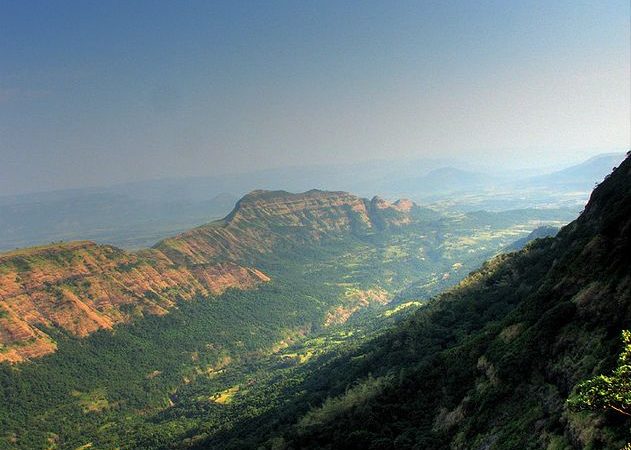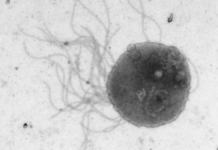The Chicxulub asteroid that collided with the Yucatán Peninsula in Mexico, and not volcanoes, drove the mass extinction that killed non-avian dinosaurs 66 million years ago, says a study published today on Science Magazine.
An international team, led by Yale scientists, analysed the volcanic activity of the Deccan Traps, in India, and concluded that more than half of the gas emissions of that massive volcano occurred well before the asteroid impact. Thus, only the impact coincided with the mass extinction and created the opportunity for the rise of Cenozoic species.
Deccan volcanism, on the other hand, may have played a role in the aftermath, shaping the conditions for new species to arise after the mass extinction, the authors suggest.
Recent studies
In February of last year, two independent studies, published on Science, by Sprain et al. and Schoene et al, reconstructed the geological time scale of the K-Pg extinction. Both studies concluded that the massive volcanic activity and the K-Pg extinction happened roughly in the same period.
However, the two teams disagree on the importance of the volcanic eruptions: while Sprain argued that volcanic eruptions had very limited responsibility in the extinction, Schoene poses that the impact and the volcano share the burden of the annihilation.
The study published today in Science focused not on lava analysis but on the gas emissions of the volcano. Hull et al. compared global temperature records and CO2 global emissions and tested their models on different scenarios of Deccan Traps emissions. The results allowed them to exclude the hypothesis that Deccan Traps activity was the main cause for the K-Pg extinction since most of the outgassing occurred several hundred thousands of years before the K-Pg boundary.
The Alvarez (Impact) Hypothesis
The K-Pg extinction marks the Cretaceous and the Paleogene boundary. It was one of the three mass extinction events in the Planet’s history: it annihilated over 50% of all species, including all flying reptiles and more than half of plants and insects, and it brought to an end the reign of dinosaurs on Earth.
In 1980, Luis Alvarez proposed that Cretaceous-Paleogene extinction may have had an “extraterrestrial cause”, even though “little physical evidence” was available at the time. His hypothesis, based on the observation of large concentrations of iridium, a material that is extremely rare on the Earth’s crust, was that an asteroid hit Earth and formed a crater. The impact resulted in a major ejection of dust particles that filled the stratosphere, preventing sunlight from reaching the Earth’s surface, and thus causing the collapse of food chains and consequent extinction.
The existence of the Chicxulub crater, in the Yucatán Peninsula, in Mexico, was unknown to the Alvarez’s team at the time: the crater was found only later, by the end of the 1980s. In 1991, Alan R. Hildebrand and his team proposed that the asteroid that hit Chicxulub was likely to have caused the K-Pg mass extinction. More recently, in 2010, the German scientist Peter Schulte wrote a comprehensive review to support the Alvarez hypothesis, concluding that the Chicxulub impact triggered the mass extinction.
The Deccan Traps
But the impact hypothesis is far from being consensual. Greta Keller, a professor at Princeton University, US, argues that there is no evidence that the Chicxulub asteroid impact alone caused a mass extinction. Alternatively, she argues “the sudden catastrophic mass extinction at the K-Pg boundary appears to result from the unfortunate coincidence of a large impact upon a severely stressed environment due to massive volcanism (Deccan Traps) and resultant climate warming with tropical and subtropical species already on the brink of extinction”.
British volcanologist Clive Oppenheimer argued on BBC Radio’s podcast, The Life Scientific, that “the problem with the impact scenario is that there are other mass extinction further back in time, such as the extinction around 250 million years ago, that are also precisely aligned in time with massive outpourings of lava. […] it is very puzzling that this [mass extinction] at the end of the Cretaceous also coincides with a gigantic asteroid impact”.
Multiple causes
Other researchers support the hypothesis that a combination of factors, such as volcanic activity, asteroid impact and impact-related adverse environmental effects explains the disappearance of so many species at the end of the Cretaceous.
The letter “Cretaceous extinction: multiple causes”, published in Science in 2010 and signed by 29 scientists, points out that the impact scenario supported by Schulte is simplistic and calls into question that, in the past 600 million years, no other mass extinction can be explained by extraterrestrial bodies hitting Earth.
The signatories of the letter argue that, while the role of the Chicxulub asteroid can not be dismissed, marine regression, massive volcanic activity and changes in global climate patterns may have likely contributed to the K-Pg mass extinction.
References:
Alvarez, Luis W., et al. “Extraterrestrial cause for the Cretaceous-Tertiary extinction.” Science 208.4448 (1980): 1095-1108.
Archibald, J. David, et al. “Cretaceous extinctions: multiple causes.” Science 328.5981 (2010): 973-973.
Burgess, Seth. “Deciphering mass extinction triggers.” Science 363.6429 (2019): 815-816.
Hildebrand, Alan R., et al. “Chicxulub crater: a possible Cretaceous/Tertiary boundary impact crater on the Yucatan Peninsula, Mexico.” Geology 19.9 (1991): 867-871.
Hull, Pincelli, et al. “On Impact and Volcanism across the Cretaceous-Paleogene Boundary.” Science Magazine, vol. 367, no. 6475, 17 Jan. 2020, pp. 266–272., doi:10.1126/science.aay5055 Article.
Keller, Gerta. “Impacts, volcanism and mass extinction: random coincidence or cause and effect?.” Australian Journal of Earth Sciences 52.4-5 (2005): 725-757.
Schoene, Blair, et al. “U-Pb constraints on pulsed eruption of the Deccan Traps across the end-Cretaceous mass extinction.” Science 363.6429 (2019): 862-866.
Schulte, Peter, et al. “The Chicxulub asteroid impact and mass extinction at the Cretaceous-Paleogene boundary.” Science 327.5970 (2010): 1214-1218.
Sprain, Courtney J., et al. “The eruptive tempo of Deccan volcanism in relation to the Cretaceous-Paleogene boundary.” Science 363.6429 (2019): 866-870.





